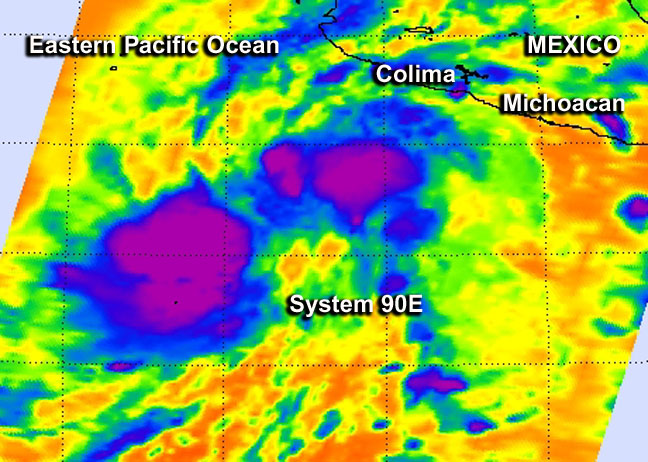NASA Watching Year's First Tropical Low Headed for Southwestern Mexico

NASA's Aqua satellite passed over developing tropical low pressure system 90E on May 8 at 08:41 UTC (4:41 a.m. EDT) and some thunderstorms had high, cold cloud top temperatures as cold as -63F/-52C (purple) indicating there was some strong uplift in the system. Image Credit: NASA JPL, Ed Olsen
NOAA's National Hurricane Center is giving it a 50 percent chance of becoming a tropical depression in the next two days, and NASA's Aqua satellite passed overhead to gather infrared data on it.
NASA's Aqua satellite passed over developing tropical low pressure system 90E on May 8 at 08:41 UTC (4:41 a.m. EDT) and infrared data from the Atmospheric Infrared Sounder (AIRS) instrument aboard, showed that some of the thunderstorms had high, cold cloud top temperatures as cold as -63F/-52C, indicating there was some strong uplift in the system.
According to the National Hurricane Center (NHC), System 90E is a broad area of low pressure located about 400 miles south-southwest of Manzanillo, Mexico (south-southeast of Michoacán state coast). The low pressure area consists of a large area of cloudiness and thunderstorms. The system is still organizing and satellite data suggest that it still lacks a well-defined center.
NHC expects System 90E to move northeastward toward the southwestern coast of Mexico, so residents should pay attention to it. According to NOAA, conditions today, May 7 at 12:00 p.m. EDT at Colima, which is located on the southwestern Mexico coast, were mostly cloudy skies with calm winds and a temperature of 71F (22C).
Even if not a tropical depression, low pressure areas containing thunderstorms with cold cloud top temperatures as those seen in today's AIRS imagery, can still drop heavy rainfall. NHC noted that “Regardless of development…locally heavy rains will begin to affect portions of southwestern Mexico today.”
NHC says that this systems as a medium chance (50 percent) of becoming a tropical cyclone during the next 2 day and 5 days.
Text credit: Rob Gutro
NASA's Goddard Space Flight Center
Media Contact
All latest news from the category: Earth Sciences
Earth Sciences (also referred to as Geosciences), which deals with basic issues surrounding our planet, plays a vital role in the area of energy and raw materials supply.
Earth Sciences comprises subjects such as geology, geography, geological informatics, paleontology, mineralogy, petrography, crystallography, geophysics, geodesy, glaciology, cartography, photogrammetry, meteorology and seismology, early-warning systems, earthquake research and polar research.
Newest articles

Webb captures top of iconic horsehead nebula in unprecedented detail
NASA’s James Webb Space Telescope has captured the sharpest infrared images to date of a zoomed-in portion of one of the most distinctive objects in our skies, the Horsehead Nebula….

Cost-effective, high-capacity, and cyclable lithium-ion battery cathodes
Charge-recharge cycling of lithium-superrich iron oxide, a cost-effective and high-capacity cathode for new-generation lithium-ion batteries, can be greatly improved by doping with readily available mineral elements. The energy capacity and…

Novel genetic plant regeneration approach
…without the application of phytohormones. Researchers develop a novel plant regeneration approach by modulating the expression of genes that control plant cell differentiation. For ages now, plants have been the…





















